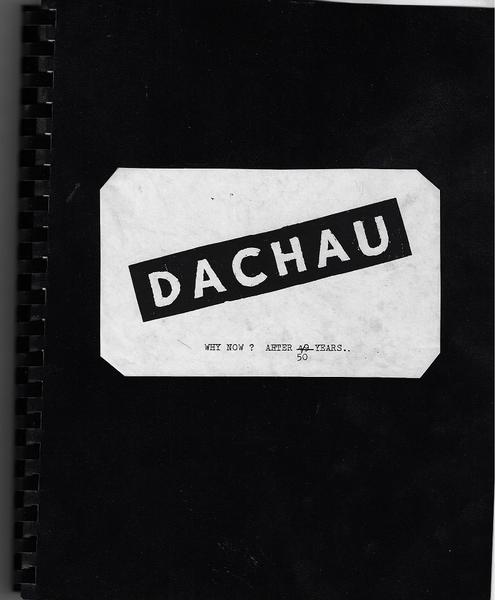WWII - Dachau - Why Now? After 50 Years.

(WWII - Dachau) Gustafson, Carroll Eugene; Distel, Barbara; Ruth Jakusch (eds). DACHAU. WHY NOW? AFTER 50 YEARS.... Concentration Camp Dachau 1933-1945. Austin,k TX; Brussels & Munich: Captain C.E. Gustafson, 3905 Grayson Lane' International Dachau Committee, 1995; 1978. Two vols. 1st -- 4to. [5], 72 leaves, photocopies, typescript, numerous text illustrations, w/ 14 black & white original photos tipped-in sized 3.5 x 3.5 in. up to 5 x 7 in. (13 of 14), maps (1 hand-colored). Plastic comb-binding, printed label on front cover, together w/ 2 original TLS -- 1 from Gustafson to Robert des Granges, San Diego, CA, the other from Archivist Robert Kesting, United States Holocaust Memorial Museum to Gustafson dated June 29, 1995, other photocopied letters, manuscript, clippings, laid-in, still VG copy; 2nd -- [2], 229, [1] pp. With 100s of photo illustrations, text illustrations. Self-printed color-illustrated softcovers, wraparound cover art (minor shelfwear, rubbing), still VG.
Typescript manuscript with original photographs of the first work, and the second an exhibition catalog, both detailing the horrors of the Dachau Concentration Camp and the controversy behind the liberation. Gustafson (1916-2001) had served as Captain with Company B, 942nd Aviation Engineer Topographical Battalion, as part of the 8th Army Air Force headquarters, and forcefully asserts with maps, recollections, quotes from works by Robert Abzug and Felix Sparks that the liberation of Dachau had not taken place until May 2, 1945, six days before Adolf Hitler’s suicide. He had written an earlier article in 1964 about his experiences at Dachau, and in this he further expands on the account, as well as using photographs reprinted from original negatives taken by John Lievens. Primarily this is written after taking offense to summary treatment by Abzug and Sparks both, but the documents included often contradict each other, and although he does note the misattribution of a couple photographs (1 credited as Dachau has a wooden fence, while Dachau had concrete moat and berm), nonetheless it does provide an excellent first-person narrative of the chilling discoveries at the end of World War II, with deeply shocking photos showing the piles of corpses, the bodies piled next to the crematoriums, and the general condition of the prisoners. In addition, there is even included a contemporary photo of the author standing near the historic Munich Beer Hall. It should be noted that several illustrations in the Exhibition Catalogue include documents specifically dated April 30, 1945 and May 1, 1945, including posted notices that the Camp was to be transferred to the authority of the President of the International Prisoner’s Committee, with specific proscriptions against arbitrary personal vendettas. Sparks was also witness to one of the most controversial moments surrounding the liberation of Dachau when enraged and shocked American Troops opened fire on Nazi SS and Wehrmacht guards, and Sparks himself had restrained one of his commanders Bill Walsh from shooting more than four of them, noted here in this manuscript as the “Curse and Quick-draw” incident, as well as descriptions of souvenir looting by U.S. personnel. This manuscript was copied and filed with the Holocaust Museum, as well as US Army Archives, but this appears to be the only copy of the original manuscript with tipped-in photographs. See: Robert H. Abzug, Inside the Vicious Heart (1985).
